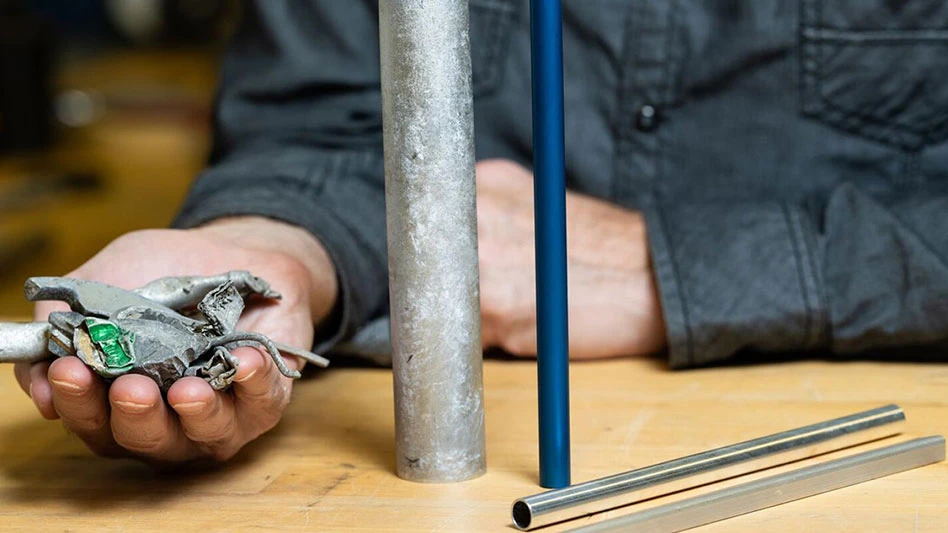
Photo courtesy of PNNL
Atomic13, a startup company formed by Eric Donsky, intends to scale a process developed by the U.S. Department of Energy’s (DOE’s) Pacific Northwest National Laboratory (PNNL) in Richland, Washington, to recycle aluminum scrap into a portfolio of low-carbon extruded parts, initially targeting the building and construction industry.
Atomic 13 has signed an exclusive agreement with PNNL to commercialize its Shear Assisted Processing and Extrusion (ShAPE) technology in certain fields of use and aims to create a variety of custom-extruded aluminum parts for the building and consumer product industries, relying entirely on postconsumer aluminum scrap. The energy savings are expected to assist builders aiming to meet or exceed Leadership in Energy and Environmental Design (LEED) standards for energy-efficient buildings, among other benefits.
ShAPE technology, which was developed and patented by PNNL, has been used to transform factory-generated scrap from automotive and supplier plants directly into suitable material for new vehicle parts. Last April, PNNL announced that it had worked with Canada-based automotive components maker Magna International to use the ShAPE process to transform aluminum production scrap directly into new vehicle parts for electric vehicles (EVs) in particular.
PNNL says the extrusions produced using the ShAPE process meet or exceed ASTM standards for strength and flexibility for common building-grade alloys 6061 and 6063, adding that ShAPE technology unlocks the possibility of creating circularity in aluminum scrap markets, thereby reducing dependency on imported primary aluminum and the massive amounts of energy associated with its production.
“With approximately 55 percent of the global aluminum extrusion market servicing the building and construction industry, the evolution of ShAPE to include aluminum recycling for building structures is an enormous opportunity for decarbonizing the built environment,” PNNL Chief Scientist and lead ShAPE researcher Scott Whalen says. “We are finding that the unique microstructures within the metal are more tolerant to impurities than previously thought. This enables us to reach even deeper into the aluminum scrap market while maintaining material performance.”
“The ShAPE technology is an amazing opportunity for U.S. manufacturing and the build-out of our critical infrastructure,” Atomic13 founder Donsky says. “We believe there is tremendous environmental and commercial value to building circularity in the aluminum extrusion industry while helping the building and construction industry significantly reduce the embodied carbon of their products. ShAPE technology enables companies like Atomic13 to produce aluminum extrusions made from 100 percent-postconsumer scrap with 90 percent lower carbon. At the same time, the low feedstock costs result in lower costs for consumers. We look forward to continuing to work with PNNL engineers to advance this promising technology.”
PNNL says that in the ShAPE manufacturing process, aluminum scrap bricks or rod-shaped billets are deformed using heat generated by high shear forces to pulverize impurities in scrap aluminum into tiny particles and uniformly disperse them within the aluminum microstructure. This dispersion eliminates microscopic iron clumps, for example, that can generate microfractures in recycled aluminum products manufactured using conventional methods. ShAPE aluminum extrusion offers considerable energy savings by eliminating the need to dilute impurities found in recycled aluminum with 25 percent to 40 percent newly mined aluminum before processing, according to the laboratory.
The PNNL team evaluated the mechanical properties of rods, tubes and irregular hollow, multichannel trapezoids under mechanical stress. The team tested 540 unique-conditions products made from postconsumer scrap briquettes, some with high (0.2 percent to 0.34 percent) iron content. All performed at or above ASTM standards for yield strength and ultimate tensile strength, PNNL says.
According to the London-based International Aluminum Organization, producing 1 metric ton of molten aluminum requires 16.6 megawatt hours of electricity. Globally, the aluminum industry produced more than 69,000 metric tons of primary aluminum in 2022. Half of that came from China, which uses coal-fired power to generate the 16.6-megawatt hours of electricity, generating 17 tons of carbon dioxide emissions per ton of aluminum produced.
“The ShAPE manufacturing process conserves energy and eliminates greenhouse gas emissions on several fronts,” Whalen explains. “First, we avoid the need to add primary aluminum. Then, we eliminate the need for what is called homogenization of the billet material, a six to 24-hour heat treatment near 500 C prior to extrusion.”
In addition, eliminating the need to add newly mined aluminum greatly reduces the manufacturing cost, opening the door to a larger market for what has been considered lower-grade “twitch” aluminum scrap, PNNL says.
“Creating a circular market that provides a value proposition for this twitch scrap opens up the possibility for new industrial uses in the building industry, among sporting goods manufacturers, auto parts and framing for emerging industries such as solar panel manufacturing,” Donsky says.
Atomic13 is in the design phase of its first commercial manufacturing line with a leading equipment company in the extrusion industry and is evaluating site locations in the Midwest and Southeast. The company is in discussions with builders and construction companies interested in sustainability and the decarbonization of building materials and plans to accept orders by early 2025, PNNL notes in a news release about the company’s startup.
This research received support from DOE’s Office of Energy Efficiency & Renewable Energy, Vehicle Technologies Office, Lightweight Materials Consortium (LightMAT). ShAPE technology has been granted seven U.S. patents with 34 patents pending. The technology is available for licensing in various fields of use. For more information about licensing opportunities, contact PNNL’s Office of Commercialization.
Get curated news on YOUR industry.
Enter your email to receive our newsletters.Latest from Recycling Today
- Republic Services, Blue Polymers open Indianapolis recycling complex
- Altilium produces EV battery cells using recycled materials
- Brightmark enters subsidiaries of Indiana recycling facility into Chapter 11
- Freepoint Eco-Systems receives $50M loan for plastics recycling facility
- PET thermoform recycling the focus of new NAPCOR white paper
- Steel Dynamics cites favorable conditions in Q1
- Hydro starts up construction in Spain
- Green Cubes unveils forklift battery line






